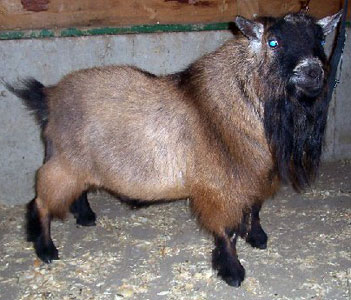 |
We are very excited to announce that Baseball Fields Yao Ming finished his final leg on October 6th, 2012 and is now a PERMANENT GRAND CHAMPION! |
Rainbow Spring Acres specializes in the breeding of registered pygora goats and pygmy goats and producing quality fleece for spinning. All of our NPGA registered pygmy goats and PBA registered pygora goats are bred for balance and correctness according to the breed standards of the National Pygmy Goat Association and the Pygora Breeders Association.

Fran with winning fleece in Oregon
Certifications
In order to ensure our goats are disease-free, we proactively decided in 2004 to herd test for the Caprine Arthritis-Encephalitis (CAE) Virus and Johne's Disease and volunteered to participate in the Scrapie Flock Certification Program. Feel free to review our current CAE test results, current Johne's test results and our Scrapie certificate.
Please note: These test results include all goats on my property but Cornell lists the Pygoras as Pygmies.
What is the CAE Virus? Transmission of this slow growing retrovirus generally occurs from doe to kids through milk and colostrum. It can also be transmitted before and during birthing of a positive doe from contact with maternal secretions. Clinical symptoms may be delayed. The virus can shed by both goats showing symptoms and goats that are still asymptomatic. There are two major forms of CAE. Two to six month old kids that are infected typically show neurologic symptoms associated with encephalitis. Goats six months and older become arthritic and suffer chronic joint inflammation. Other signs may include chronic pneumonia, mastitis of the udder, and systemic illnesses. Once infected, there is no cure for CAE. [Source: University of Minnesota Ext.]
What is Johne's Disease? Disease infection is usually acquired early in life, but the clinical signs can take 2-6 years to develop which include severe wasting due to prolonged diarrhea, dehydration, and emaciation with lethal consequences. The intestinal wall becomes thickened and has transverse folds called rugae. The surface looks corrugated. Lymph nodes are also affected and at times there are lesions in the liver, spleen, lungs, kidneys. Infections in the uterus and placenta can lead to congenital infection and abortion. Infection generally occurs when young through contaminated feed, colostrum, milk, contaminated bedding and water. The organism is often shed in large number in the feces and for long periods of time. It can live for long periods in fecal material and depending on the environmental and soil conditions, has been known to survive up to 1 year. Once infected, there is no cure for Johne's Disease. [Source: U.S. Dept. of Agriculture]
What is Scrapie Disease? A fatal, degenerative disease that affects the central nervous system of goats. It is among a number of diseases classified as transmissible spongiform encephalopathies (TSE). Infected flocks that contain a high percentage of susceptible animals can experience significant production losses. Over a period of several years the number of infected animals increases, and the age at onset of clinical signs decreases making these flocks economically unviable. Animals sold from infected flocks spread scrapie to other flocks. [Source: U.S. Dept. of Agriculture]

Moon over Lysander!
Caring for Goats
Pygora goats are fairly easy to keep. They need about 15 to 20 square feet per animal and the area of the barn where they are kept should be draft free. They love to jump and sleep on shelves or other structures available.
Goats are ruminants which means that they have a stomach with four chambers and digest their food in two steps. The chambers are called the rumen, reticulum, omasum, and abomasum. In the first two chambers, the food is mixed with saliva and separates into layers of solid and liquid material. Solids clump together to form the cud. The cud is then regurgitated, chewed slowly to completely mix it with saliva and to break down the particle size.
Unlike the popular old wives' tale, pygmy goats do not eat tin cans and actually can be quite finicky! Their diets typically consist of a mixture of hay and grain and should have fresh, clean water available to them at all times.




